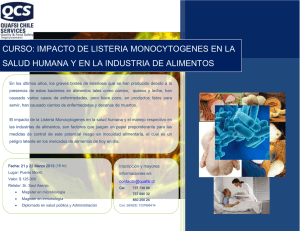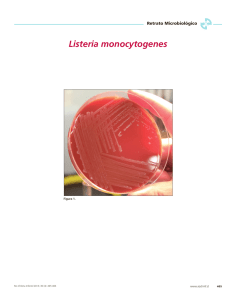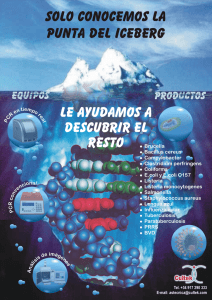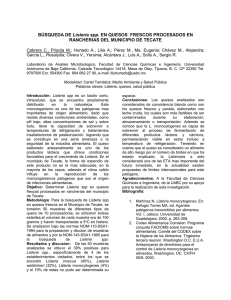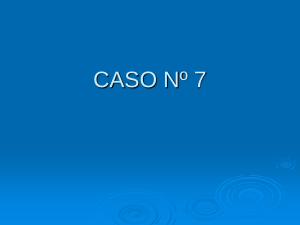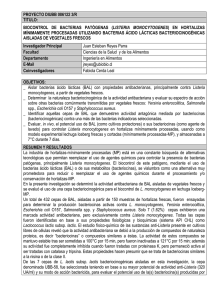Detección rápida de patógenos en superficies
Anuncio
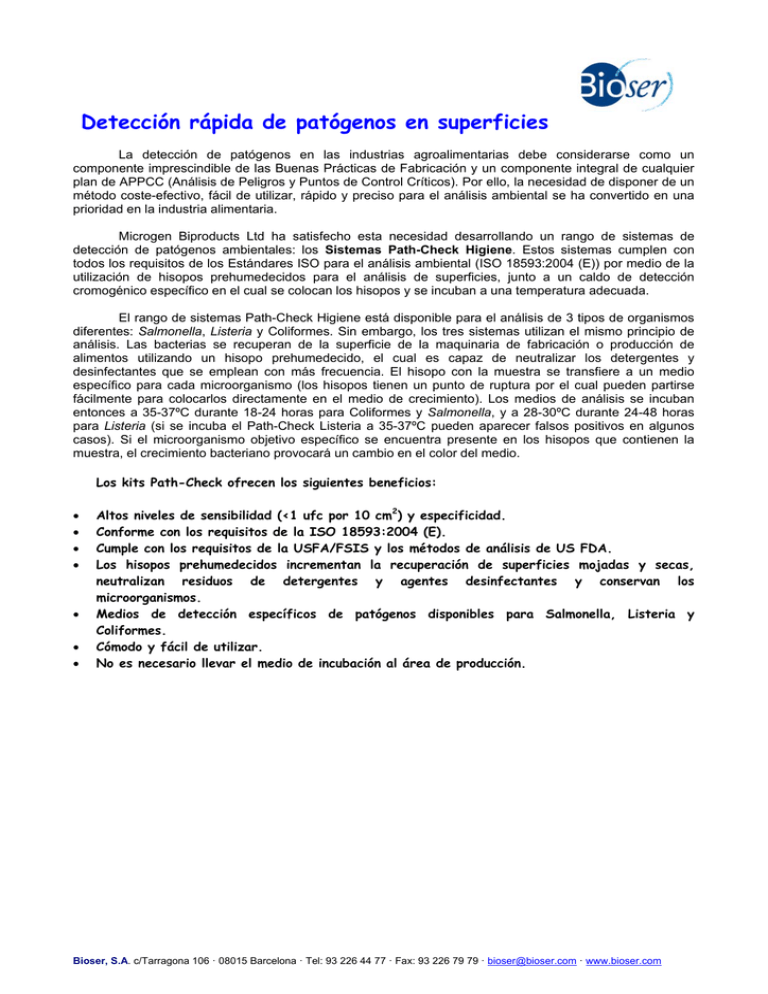
Detección rápida de patógenos en superficies La detección de patógenos en las industrias agroalimentarias debe considerarse como un componente imprescindible de las Buenas Prácticas de Fabricación y un componente integral de cualquier plan de APPCC (Análisis de Peligros y Puntos de Control Críticos). Por ello, la necesidad de disponer de un método coste-efectivo, fácil de utilizar, rápido y preciso para el análisis ambiental se ha convertido en una prioridad en la industria alimentaria. Microgen Biproducts Ltd ha satisfecho esta necesidad desarrollando un rango de sistemas de detección de patógenos ambientales: los Sistemas Path-Check Higiene. Estos sistemas cumplen con todos los requisitos de los Estándares ISO para el análisis ambiental (ISO 18593:2004 (E)) por medio de la utilización de hisopos prehumedecidos para el análisis de superficies, junto a un caldo de detección cromogénico específico en el cual se colocan los hisopos y se incuban a una temperatura adecuada. El rango de sistemas Path-Check Higiene está disponible para el análisis de 3 tipos de organismos diferentes: Salmonella, Listeria y Coliformes. Sin embargo, los tres sistemas utilizan el mismo principio de análisis. Las bacterias se recuperan de la superficie de la maquinaria de fabricación o producción de alimentos utilizando un hisopo prehumedecido, el cual es capaz de neutralizar los detergentes y desinfectantes que se emplean con más frecuencia. El hisopo con la muestra se transfiere a un medio específico para cada microorganismo (los hisopos tienen un punto de ruptura por el cual pueden partirse fácilmente para colocarlos directamente en el medio de crecimiento). Los medios de análisis se incuban entonces a 35-37ºC durante 18-24 horas para Coliformes y Salmonella, y a 28-30ºC durante 24-48 horas para Listeria (si se incuba el Path-Check Listeria a 35-37ºC pueden aparecer falsos positivos en algunos casos). Si el microorganismo objetivo específico se encuentra presente en los hisopos que contienen la muestra, el crecimiento bacteriano provocará un cambio en el color del medio. Los kits Path-Check ofrecen los siguientes beneficios: • • • • • • • Altos niveles de sensibilidad (<1 ufc por 10 cm2) y especificidad. Conforme con los requisitos de la ISO 18593:2004 (E). Cumple con los requisitos de la USFA/FSIS y los métodos de análisis de US FDA. Los hisopos prehumedecidos incrementan la recuperación de superficies mojadas y secas, neutralizan residuos de detergentes y agentes desinfectantes y conservan los microorganismos. Medios de detección específicos de patógenos disponibles para Salmonella, Listeria y Coliformes. Cómodo y fácil de utilizar. No es necesario llevar el medio de incubación al área de producción. Bioser, S.A. c/Tarragona 106 · 08015 Barcelona · Tel: 93 226 44 77 · Fax: 93 226 79 79 · bioser@bioser.com · www.bioser.com M ICROGEN B IOPRODUCTS L TD Salmonella Listeria Coliformes P ATH -C HEK H YGIENE P ATHOGEN S YSTEM T EST RÁPIDOS PARA LA DETECCIÓN DE BACTERIAS PATÓGENAS EN SUPERFICIES DE TRABAJO O MAQUINARIA • • • • A LTOS NIVELES SE SENSIBILIDAD (<1 CFU POR 10 CM 2 ) Y ESPECIFICIDAD C ONFORME CON LOS REQUISITES DE LA ISO 18593:2004( E ) C UMPLE LOS REQUISITOS DE USDA / FSIS Y LOS MÉTODOS DE ANÁLISIS DE US FDA . L OS HISOPOS PREHUMEDECIDOS INCREMENTAN LA RECUPERACIÓN DE SUPERFICIES MOJADAS Y SECAS , NEUTRALIZAN RESIDUES DE DETERGENTS Y AGENTS DESINFECTANTES Y CONSERVAN LOS MICROORGANISMOS • M EDIOS • • DE DETECCIÓN ESPECÍFICOS DE PATÓGENOS DISPONIBLES PARA L ISTERIA , COLIFORMES Y SALMONELLA C ÓMODO Y FÁCIL DE UTILIZAR N O ES NECESARIO LLEVAR EL MEDIO DE INCUBACIÓN AL AREA DE PRODUCCIÓN Protegiendo la Salud y los Alimentos Bioser, S.A. c/ Tarragona 106 08015 Barcelona Tel: 93 226 44 77 Fax: 93 226 79 79 bioser@bioser.com www.bioser.com A medida que los fabricantes y productores de alimentos se dan cuenta de la importancia del control de la higiene microbiológica ambiental como parte de unas buenas prácticas de fabricación en la industria alimentaria, la necesidad de un método coste-efectivo, fácil de utilizar, rápido y preciso para el análisis ambiental ha crecido en importancia. Microgen Bioproducts Ltd ha satisfecho esta necesidad desarrollando un nuevo rango de sistemas de detección de patógenos ambientales: los sistemas Path-Chek Higiene. Estos sistemas cumplen todos los requisitos de los Estándares ISO para el análisis ambiental (ISO 18593:2004 (E)) por medio de la utilización de hisopos prehumedecidos para el análisis de superficies, junto a un caldo de detección cromogénico específico de organismos en el cual se colocan los hisopos y se incuban a la temperatura adecuada. El rango de los sistemas Path-Chek Higiene consiste en análisis para 3 tipos de organismos: Listeria, Coniformes y Salmonella. Los tres sistemas utilizan un el mismo principio de análisis. Las bacterias se recuperan de la superficie de maquinaria de fabricación o producción de alimentos utilizando un hisopo prehumedecido, el cual es capaz de neutralizar los detergentes y desinfectantes que se emplean con más frecuencia. El hisopo con la muestra se transfiere a un medio específico para organismos (los hisopos tienen un punto de rotura por el cual pueden romperse fácilmente para colocarlos directamente en el medio de crecimiento). Los medios de análisis se incuban entonces a 35-37ºC durante 18-24 horas para Coliformes y Salmonella, y a 28-30ºC durante 24-48 horas para Listeria (si se incuba el Path-Chek Listeria a 35-37ºC, en algunos casos pueden aparecer falsos positivos). Si la bacteria objetivo específica se encuentra presente en los hisopos con la muestra, el crecimiento bacteriano provocará un cambio en el color del medio. Reacciones del test: Resultado para Coliformes: Positivo Negativo Resultados para Salmonella: Positivo Negativo Resultado Para Listeria: Positivo Swabs Microgen Path-Chek Higiene Formato: 100 swabs Conservación: Temp. ambiente 025040100 (PCS-100) Negativo Path-Chek Hygiene Pathogen Detection Broth Formato: Conservación: Listeria Salmonella Coliformes 100 ud. 2-8°C 025039100 (PCS-080) 025038100 (PCS-020) 025037100 (PCS-010) 2007-01 Technical Bulletin No. 108 Improved Specificity of Path-Chek Hygiene Listeria All internationally accepted standards for the isolation of Listeria spp. and L. monocytogenes from food samples recommend that all pre-enrichment and sometimes enrichment broths are incubated at 30°C rather than 35 - 37°C, (ISO 11290 -1:1996, AS/NZS 1766.2.16: 1998, US FDA BAM/AOAC). One rationale for this initial lower incubation temperature is that Listeria spp. and in particular L. monocytogenes may not grow well in these media when incubated at 35 - 37°C and that in cases of mixed populations of Listeria spp., L. innocua may in fact overgrow L. monocytogenes at this incubation temperature but not at 30°C. A study was performed in an independent Public Health Food Testing Laboratory to ascertain the potential effects of incubating the Path-Chek Hygiene Listeria at 30°C rather than 35 - 37°C. This study was performed using a range of environmental samples taken from a local food manufacturer who is known to have Listeria in their work environment. In this trial each sample area was swabbed in triplicate, one swab was processed in Path-Chek Hygiene at an incubation temperature of 37°C, a second swab was processed similarly, but incubated at 30°C. The third swab was transferred into 10ml UVM broth which was incubated for 48 hours at 30°C after which a sample of the broth was examined for the presence of Listeria spp. using an AOAC Approved Listeria EIA. All Path-Chek Listeria tests were subcultured onto Oxford Agar and incubated at 37°C for 48 hours and examined for colonies resembling Listeria spp. after 48 hours incubation. All suspicious colonies were Gram stained and subjected to appropriate identification tests to include or exclude Listeria spp. RESULTS A total of 35 environmental samples were examined for the presence of Listeria spp.. Three samples were found by all 3 methods to contain L. monocytogenes, Path-Chek Hygiene Listeria was able to detect the presence of these 3 positive samples after only 24 hours incubation, more than 24 hours earlier than the testing laboratories control method (Table 1.). Although the results of this trial did not demonstrate any differences between the isolation of Listeria spp. in the 3 positive samples, this investigation did demonstrate a significant decrease in the number of false positive results in the Path-Chek Hygiene Listeria tests that were incubated at 30°C when compared to those incubated at 37°C. After 24 hour incubation at 30°C, only 2 samples produced false positive results, whilst the same samples incubated at 37°C produced 9 false positive results. After a total of 48 hours incubation, the tests incubated at 37°C produced 13 false positive results, whilst those incubated at 30°C produced only 6 false positive tests. 6 positive results at 48 hours at both 30°C and 37°C, showed no growth once sub-cultured on the Oxford Agar plates, producing no identification as the organism in the broth did not grow on the Oxford Agar plates. Based on this investigation it is clear optimum results for Path-Chek Hygiene Listeria are obtained at 30°C and should be examined for a colour change indicative of the presence of Listeria spp. after both 24 and 48 hours. Microgen Bioproducts Ltd, 1 Admiralty Way, Camberley, Surrey GU15 3DT. Tel +44 (0) 1276 600081, Fax +44 (0) 1276 600151 www.microgenbioproducts.com Swab Source 1. Floor near sliding door 2. Drain in holding room 3. Rubber on sliding door 4. Production room drain 5. Production room floor 6. Floor under pump 7. Floor in corner 8. Floor mat near pack line 9. Coolroom floor 10. Blast room sliding door 11. Wheels on pump frame 12. Wheels on pump track 1 13. Wheels on pump track 2 14. Wheels on pump track 4 15. Wheels on pump track 3 16. Wheels on pump 2 17. Wheels on pump 3 20. Chiller slide door 26. Open drain 27. Chiller slide door 28. Underneath bench 29. Floor near pallet 30. Drain near foot bath 31. Drain in batching area 32. Fllor in blast chiller 33. Wall in thawing room 34. Door in thawing room 35. Door in chiller Path Chek Listeria 30C Incubation Esculin reaction 24hr 48hr + + + + + + + + + + + + + + - Typical colonies on Oxford Agar No No Growth No No Yes Yes Yes No Growth No Growth Identification GPC GPC GPB L. monocytogenes L. monocytogenes L. monocytogenes Path Chek Listeria 37C Incubation Esculin reaction 24hr 48hr + + + + + + + + + + + + + + + + + + + + + + + + + + + + - Typical colonies on Oxford Agar No No Growth No No Growth No No Growth No Growth No Yes No Growth EIA result Identification GPC GPC GPC GPB GPB Yes Yes Yes L. monocytogenes L. monocytogenes L. monocytogenes No No Growth GPB No Growth Identification + + + - L. monocytogenes L. monocytogenes L. monocytogenes Table 1. Comparison of Path-Chek Hygiene Listeria tests incubated at 30°C and 37°C and control EIA System for environmental samples. GPC = gram-positive cocci, presumptively identified as E. faecalis GPB = gram-positive bacilli, presumptively identified as Bacillus spp. Microgen Bioproducts Ltd, 1 Admiralty Way, Camberley, Surrey GU15 3DT. Tel +44 (0) 1276 600081, Fax +44 (0) 1276 600151 www.microgenbioproducts.com
